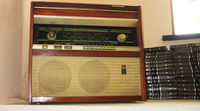Radio
From Just Solve the File Format Problem
(Difference between revisions)
Dan Tobias (Talk | contribs) (→External links) |
Dan Tobias (Talk | contribs) (→External links) |
||
| Line 33: | Line 33: | ||
* [http://radiosearchengine.com/ Radio search engine: finds station that's playing your song] | * [http://radiosearchengine.com/ Radio search engine: finds station that's playing your song] | ||
* [https://archive.org/stream/rm_Century_21_Sales_Brochure_1980/Century_21_Sales_Brochure_1980#page/n0/mode/2up Sales brochure showing how formulaic radio was getting even back around 1980] | * [https://archive.org/stream/rm_Century_21_Sales_Brochure_1980/Century_21_Sales_Brochure_1980#page/n0/mode/2up Sales brochure showing how formulaic radio was getting even back around 1980] | ||
| + | * [https://archive.org/details/RadioMonitoringTheHowToGuide Radio Monitoring: The How To Guide] | ||
Revision as of 02:01, 22 July 2014
Radio is the use of electromagnetic waves for communication. This is used both for broadcast (one-to-many) and point-to-point (one-to-one) communication of voice, music, code, and other data. Transmission of video by radio waves is known as television. Transmissions can be analog or digital. These days, broadcasts are often simulcast on the Internet as well.
Contents |
Transmission modes
Digital data
- Radio Data System (RDS, RBDS)
Emergency broadcasts
Other
- Call signs (call letters of stations)
See also Audio and Music and Video for particular encoding formats for those types of media, and Morse code (which is under Character Encodings).
